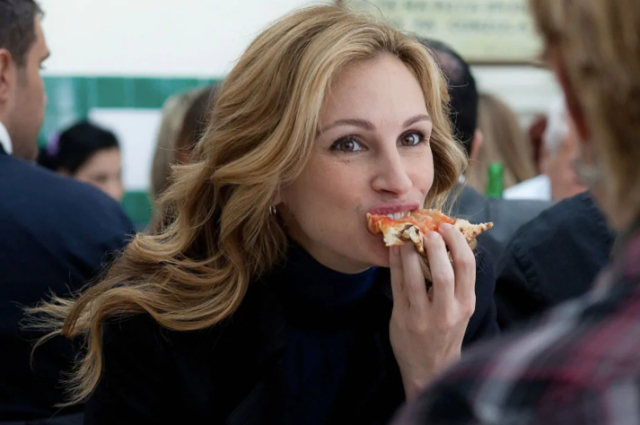Okay. I’ll admit it. I kind of let the finer points of Italian dining culture slip by me until I was in my 40s. That was before I became formally interested in food and cooking. And I thought spaghetti and meatballs, veal scallopini, Chef Boyardee ravioli and pizza were about the extent of it…
 Julia Roberts nibbles on an authentic Italian snack pizza: Thin, crispy
Julia Roberts nibbles on an authentic Italian snack pizza: Thin, crispy
crust with a few simple, finely-chopped savoury toppings.
Not unlike another Italian treat – Bruschetta.
Then came The Sopranos. They gathered around their family dining table at least once per episode, passing around course after course of great-looking (and sounding) stuff, most of which I’d never heard about before. I always promised myself I’d look it up; find out what anti patti and insalata were. And why Tony and his brood always ate their pasta naked – that is, with just sauce, and saving meat for later.
Then came culinary school, and I learned about many different dining traditions – and Italian sort of faded into the background. I guess the instructors at school (who knew all about it) assumed Italian was already familiar to us, too, since were were interested in food. Anyway, we never formally covered it.
Then, just recently, I was talking to our local Italian grocery guy and was rudely awakened to the fact that I knew hardly anything about his world.
So I finally Googled ‘Italian Dining Culture’, and got back a whole boatload of hits. And quickly learned that I had been missing out on a lot all the years up until then…
First things first
The first thing you learn about Italian dining is that their meal architecture is unlike that of any other culture. They have courses nobody else has, and break down the ones we do know in an manner we would never have guessed.
The traditional courses of a traditional Italian family meal go like this…
Aperitivo
According to the website of an eponymously named restaurant in the next town over from mine, on the outskirts of Canada’s capital: “Aperitivo is a term used in both Spain and Italy that simply means: A pre-dinner drink or snack, meant to ‘open’ the palate. It gives you a chance to socialize, relax, and nibble in a cozy, informal setting as dinner approaches.”
It’s the Italian version of ‘cocktail nibbles’ or the French hors-d’œuvre. “[That] literally means “outside the work”; “not part of the ordinary set of courses in a meal”. In practice, it is a dish which can stand on its own as a snack or supports the main course.” (Wikipedia) Not as varied or elaborate as Portuguese/Spanish Tappas, or ‘appetizers’ in the rest of Europe.
Anti Patti
Equivalent to ‘appetizers’ in the rest of Europe (and the world). Literally means, “before the main, formal meal.” This starter course is sometimes equated with the French ‘chacouterie’ platter, or cold cuts spread.
Traditional components include salami, mortadella, and prosciutto, along side cheeses like pecorino, mozzarella, and parmigiano-reggiano. Usually accompanied by small, slices of crusty bread such as crostini. The latter coming in handy to keep your hands relatively clean, since anti patti are usually eaten with the fingers.
By the numbers…
Primi Patti
Literally, ‘First Course’. This is always the Pasta Course in Italy. As we mentioned earlier, it’s long pasta such as Spaghetti, Fettuccini or Tagliatelli, served with a simple sauce, such as Marinara, Bolognese, Alfredo, Garlic Butter, or Pomodoro. May also be a short pasta such as Penne, Rotini, Orechiette, Shells or Macaroni, either served loose with o simple sauce or baked in a casserole, topped with sauce and grated cheese.
Secondi Piatti
This is the apex of the meal: meat or fish. Might be sausage, veal, steak, rabbit, chicken, or lamb. Or any of several kinds of fish or deafood. Often accompanied by rich, creamy sauces.
Contorni
Perhaps the least known of the formal Italian courses, at least by its proper name. This is basically your side dish or dishes, considerd optional by purists. Here is where your fancier veggie dishes come in. Broccoli is often featured. Potato and squash dishes also show up here.
Fresh and sweet…
Insalata
Salad. What we (and the rest of the world) would call a Chef’s Salad. May also be a Panzanella or a Caprese, or something similar. Not just a side dish, but a true course on its own. Italy is the only dining cuture that places the Salad at the end of the meal (I think). But after experiencing the authentic Italian dinner I can definitely appreciate how having the sald here cleans tour palate and provides a bright, fresh high note on which end an otherwise heavy, rich meal.
Dolce
Dessert. Or, as the Brits call it, ‘the Sweet’. ‘Dolce’ is simply Italian for ‘sweet’, which emphasizes the contrast on your palate this final, formal course presents to the rest of the meal – which has been savoury, umami and perhaps even peppery hot. Italians love their sweets and there are hundreds of different ones to salivate over. They’re often elaborately decorated may feature any of many different fruit, nut or confectionery flavour themes.
If you’re dining formally in Italian, always be sure to leave room for dessert!
Got that?
If you want a good little giggle, screen Eat, Pray, Love (the hit 2010 chick flick starring Julia Roberts) and wait for the scene where she learns to order a proper Italian meal like a native. This is also the movie responsible for me developing a personal taste for Javier Bardem. (But that’s a different story, for a different day, in a different blog!)
I hope the foregoing helps you enjoy a deeper appreciation for the authentic formal Italian dinner, in all its quirky glory!
~ Maggie J.

